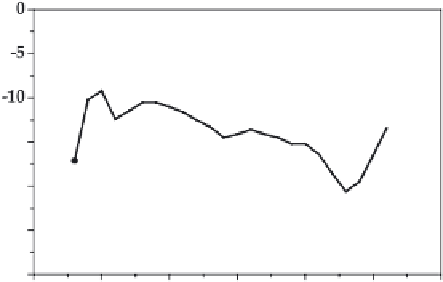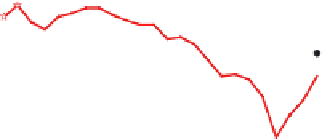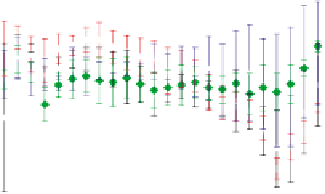Geoscience Reference
In-Depth Information
WIN
PRM
MON
POM
Fig. 5b. Longitudinal variation of anthropogenic surface forcing in the IGB during
the winter (WIN), pre-monsoon (PRM), monsoon (MON), and post-monsoon (POM)
seasons. The vertical bars through each point represent the standard deviation for
2001-2005.
up along the major urban locations and continued until January. The
anthropogenic atmospheric forcing remains high (
+12 W m
−
2
)overthe
major urban locations throughout the year. However, during the winter due
to the low-level inversions, a pool of high anthropogenic atmospheric forcing
(
>
+24 W m
−
2
) exists over the entire IGB. The highest anthropogenic
contribution to the observed aerosol forcing in the IGB comes from the
seven mega cities (Fig. 1). The longitudinal variation of anthropogenic
surface forcing (Fig. 5(b)) shows reverse trend as that of surface ADRF. The
anthropogenic surface forcing is less than
>
15 W m
−
2
for most of the places
in the western and central IGB, but increases sharply toward the east of
that for the winter and pre-monsoon seasons. Anthropogenic surface forcing
is least during the pre-monsoon season in the western IGB, east of which,
the forcing values for monsoon and post-monsoon seasons catch up with
each other and the pre-monsoon forcing dips below
−
15 W m
−
2
to catch
up with the wintertime forcing values. The strong spatial heterogeneity in
anthropogenic contribution to ADRF in the IGB is due to complex nature
of aerosol loading in the region, resulting from the mixing of anthropogenic
and natural aerosols. Past studies (Ref. 5 and the references therein) have
shown that the natural dusts are transported every year to the IGB, but
their effect on the ADRF is dominant mostly in the western and central
parts of the basin. The eastern part remains relatively unaffected from the
dust storms.
−






































